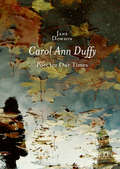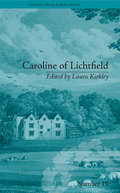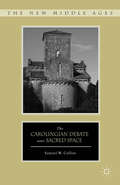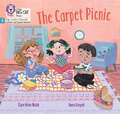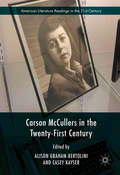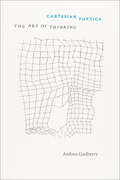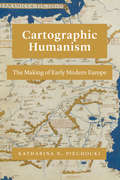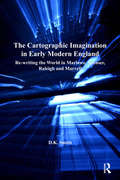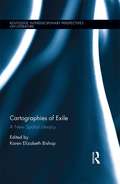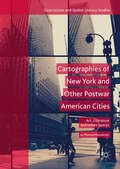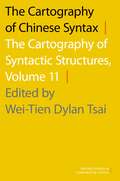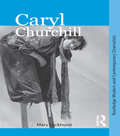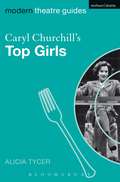- Table View
- List View
Carol Ann Duffy: Poet for Our Times
by Jane DowsonThis is the only monograph to consider the entire thirty-year career, publications, and influence of Britain's first female poet laureate. It outlines her impact on trends in contemporary poetry and establishes what we mean by ‘Duffyesque’ concerns and techniques. Discussions of her writing and activities prove how she has championed the relevance of poetry to all areas of contemporary culture and to the life of every human being. Individual chapters discuss the lyrics of ‘love, loss, and longing’; the socially motivated poems about the 1980s; the female-centred volumes and poems; the relationship between poetry and public life; and poetry and childhood and written for children. The book should whet the appetite of readers who know little of Duffy’s work to find out more, while providing students and scholars with an in-depth analysis of the poems in their contexts. It draws on a wide range of critical works and includes an extensive list of further reading.
Caroline of Lichtfield: by Isabelle de Montolieu (Chawton House Library: Women's Novels #19)
by Laura KirkleyThomas Holcroft’s 1786 translation of Isabelle de Montolieu’s novel is a textual encounter between a rather conventional Swiss woman and a British radical. Just as Montolieu did in her own translations, Holcroft reworked parts of the novel to make it more appealing to his intended audience.
Caroline of Lichtfield: by Isabelle de Montolieu (Chawton House Library: Women's Novels)
by Laura KirkleyThomas Holcroft’s 1786 translation of Isabelle de Montolieu’s novel is a textual encounter between a rather conventional Swiss woman and a British radical. Just as Montolieu did in her own translations, Holcroft reworked parts of the novel to make it more appealing to his intended audience.
The Carolingian Debate over Sacred Space (The New Middle Ages)
by S. CollinsRetracing the contours of a bitter controversy over the meaning of sacred architecture that flared up among some of the leading lights of the Carolingian renaissance, Collins explores how ninth-century authors articulated the relationship of form to function and ideal to reality in the ecclesiastical architecture of the Carolingian empire.
The Carpet Picnic: Phase 3 Set 2 (Big Cat Phonics For Little Wandle Letters And Sounds Revised Ser.)
by Clare Helen Welsh Asma Enayeh Collins Big CatCarson McCullers in the Twenty-First Century (American Literature Readings in the 21st Century)
by Alison Graham-Bertolini and Casey KayserThe contributors to this volume use diverse critical techniques to identify how Carson McCullers’ writing engages with and critiques modern social structures and how her work resonates with a twenty-first century audience. The collection includes chapters about McCullers’ fiction, autobiographical writing, and dramatic works, and is groundbreaking because it includes the first detailed scholarly examination of new archival material donated to Columbus State University after the 2013 death of Dr. Mary Mercer, McCullers’ psychiatrist and friend, including transcripts of the psychiatric sessions that took place between McCullers and Mercer in 1958. Further, the collection covers the scope of McCullers’ canon of work, such as The Heart Is a Lonely Hunter (1940), The Member of the Wedding (1946), and Ballad of the Sad Café (1943), through lenses that are of growing interest in contemporary literary studies, including comparative transatlantic readings, queer theory, disability studies, and critical animal theory, among others.
Cartesian Poetics: The Art of Thinking (Thinking Literature)
by Andrea GadberryWhat is thinking? What does it feel like? What is it good for? Andrea Gadberry looks for answers to these questions in the philosophy of René Descartes and finds them in the philosopher’s implicit poetics. Gadberry argues that Descartes’s thought was crucially enabled by poetry and shows how markers of poetic genres from love lyric and elegy to the puzzling forms of the riddle and the anagram betray an impassioned negotiation with the difficulties of thought and its limits. Where others have seen Cartesian philosophy as a triumph of reason, Gadberry reveals that the philosopher accused of having “slashed poetry’s throat” instead enlisted poetic form to contain thought’s frustrations. Gadberry’s approach to seventeenth-century writings poses questions urgent for the twenty-first. Bringing literature and philosophy into rich dialogue, Gadberry centers close reading as a method uniquely equipped to manage skepticism, tolerate critical ambivalence, and detect feeling in philosophy. Helping us read classic moments of philosophical argumentation in a new light, this elegant study also expands outward to redefine thinking in light of its poetic formations.
Cartesian Poetics: The Art of Thinking (Thinking Literature)
by Andrea GadberryWhat is thinking? What does it feel like? What is it good for? Andrea Gadberry looks for answers to these questions in the philosophy of René Descartes and finds them in the philosopher’s implicit poetics. Gadberry argues that Descartes’s thought was crucially enabled by poetry and shows how markers of poetic genres from love lyric and elegy to the puzzling forms of the riddle and the anagram betray an impassioned negotiation with the difficulties of thought and its limits. Where others have seen Cartesian philosophy as a triumph of reason, Gadberry reveals that the philosopher accused of having “slashed poetry’s throat” instead enlisted poetic form to contain thought’s frustrations. Gadberry’s approach to seventeenth-century writings poses questions urgent for the twenty-first. Bringing literature and philosophy into rich dialogue, Gadberry centers close reading as a method uniquely equipped to manage skepticism, tolerate critical ambivalence, and detect feeling in philosophy. Helping us read classic moments of philosophical argumentation in a new light, this elegant study also expands outward to redefine thinking in light of its poetic formations.
Cartesian Poetics: The Art of Thinking (Thinking Literature)
by Andrea GadberryWhat is thinking? What does it feel like? What is it good for? Andrea Gadberry looks for answers to these questions in the philosophy of René Descartes and finds them in the philosopher’s implicit poetics. Gadberry argues that Descartes’s thought was crucially enabled by poetry and shows how markers of poetic genres from love lyric and elegy to the puzzling forms of the riddle and the anagram betray an impassioned negotiation with the difficulties of thought and its limits. Where others have seen Cartesian philosophy as a triumph of reason, Gadberry reveals that the philosopher accused of having “slashed poetry’s throat” instead enlisted poetic form to contain thought’s frustrations. Gadberry’s approach to seventeenth-century writings poses questions urgent for the twenty-first. Bringing literature and philosophy into rich dialogue, Gadberry centers close reading as a method uniquely equipped to manage skepticism, tolerate critical ambivalence, and detect feeling in philosophy. Helping us read classic moments of philosophical argumentation in a new light, this elegant study also expands outward to redefine thinking in light of its poetic formations.
Cartesian Poetics: The Art of Thinking (Thinking Literature)
by Andrea GadberryWhat is thinking? What does it feel like? What is it good for? Andrea Gadberry looks for answers to these questions in the philosophy of René Descartes and finds them in the philosopher’s implicit poetics. Gadberry argues that Descartes’s thought was crucially enabled by poetry and shows how markers of poetic genres from love lyric and elegy to the puzzling forms of the riddle and the anagram betray an impassioned negotiation with the difficulties of thought and its limits. Where others have seen Cartesian philosophy as a triumph of reason, Gadberry reveals that the philosopher accused of having “slashed poetry’s throat” instead enlisted poetic form to contain thought’s frustrations. Gadberry’s approach to seventeenth-century writings poses questions urgent for the twenty-first. Bringing literature and philosophy into rich dialogue, Gadberry centers close reading as a method uniquely equipped to manage skepticism, tolerate critical ambivalence, and detect feeling in philosophy. Helping us read classic moments of philosophical argumentation in a new light, this elegant study also expands outward to redefine thinking in light of its poetic formations.
Cartographic Humanism: The Making of Early Modern Europe
by Katharina N. PiechockiWhat is “Europe,” and when did it come to be? In the Renaissance, the term “Europe” circulated widely. But as Katharina N. Piechocki argues in this compelling book, the continent itself was only in the making in the fifteenth and sixteenth centuries. Cartographic Humanism sheds new light on how humanists negotiated and defined Europe’s boundaries at a momentous shift in the continent’s formation: when a new imagining of Europe was driven by the rise of cartography. As Piechocki shows, this tool of geography, philosophy, and philology was used not only to represent but, more importantly, also to shape and promote an image of Europe quite unparalleled in previous centuries. Engaging with poets, historians, and mapmakers, Piechocki resists an easy categorization of the continent, scrutinizing Europe as an unexamined category that demands a much more careful and nuanced investigation than scholars of early modernity have hitherto undertaken. Unprecedented in its geographic scope, Cartographic Humanism is the first book to chart new itineraries across Europe as it brings France, Germany, Italy, Poland, and Portugal into a lively, interdisciplinary dialogue.
Cartographic Humanism: The Making of Early Modern Europe
by Katharina N. PiechockiWhat is “Europe,” and when did it come to be? In the Renaissance, the term “Europe” circulated widely. But as Katharina N. Piechocki argues in this compelling book, the continent itself was only in the making in the fifteenth and sixteenth centuries. Cartographic Humanism sheds new light on how humanists negotiated and defined Europe’s boundaries at a momentous shift in the continent’s formation: when a new imagining of Europe was driven by the rise of cartography. As Piechocki shows, this tool of geography, philosophy, and philology was used not only to represent but, more importantly, also to shape and promote an image of Europe quite unparalleled in previous centuries. Engaging with poets, historians, and mapmakers, Piechocki resists an easy categorization of the continent, scrutinizing Europe as an unexamined category that demands a much more careful and nuanced investigation than scholars of early modernity have hitherto undertaken. Unprecedented in its geographic scope, Cartographic Humanism is the first book to chart new itineraries across Europe as it brings France, Germany, Italy, Poland, and Portugal into a lively, interdisciplinary dialogue.
Cartographic Humanism: The Making of Early Modern Europe
by Katharina N. PiechockiWhat is “Europe,” and when did it come to be? In the Renaissance, the term “Europe” circulated widely. But as Katharina N. Piechocki argues in this compelling book, the continent itself was only in the making in the fifteenth and sixteenth centuries. Cartographic Humanism sheds new light on how humanists negotiated and defined Europe’s boundaries at a momentous shift in the continent’s formation: when a new imagining of Europe was driven by the rise of cartography. As Piechocki shows, this tool of geography, philosophy, and philology was used not only to represent but, more importantly, also to shape and promote an image of Europe quite unparalleled in previous centuries. Engaging with poets, historians, and mapmakers, Piechocki resists an easy categorization of the continent, scrutinizing Europe as an unexamined category that demands a much more careful and nuanced investigation than scholars of early modernity have hitherto undertaken. Unprecedented in its geographic scope, Cartographic Humanism is the first book to chart new itineraries across Europe as it brings France, Germany, Italy, Poland, and Portugal into a lively, interdisciplinary dialogue.
Cartographic Humanism: The Making of Early Modern Europe
by Katharina N. PiechockiWhat is “Europe,” and when did it come to be? In the Renaissance, the term “Europe” circulated widely. But as Katharina N. Piechocki argues in this compelling book, the continent itself was only in the making in the fifteenth and sixteenth centuries. Cartographic Humanism sheds new light on how humanists negotiated and defined Europe’s boundaries at a momentous shift in the continent’s formation: when a new imagining of Europe was driven by the rise of cartography. As Piechocki shows, this tool of geography, philosophy, and philology was used not only to represent but, more importantly, also to shape and promote an image of Europe quite unparalleled in previous centuries. Engaging with poets, historians, and mapmakers, Piechocki resists an easy categorization of the continent, scrutinizing Europe as an unexamined category that demands a much more careful and nuanced investigation than scholars of early modernity have hitherto undertaken. Unprecedented in its geographic scope, Cartographic Humanism is the first book to chart new itineraries across Europe as it brings France, Germany, Italy, Poland, and Portugal into a lively, interdisciplinary dialogue.
Cartographic Humanism: The Making of Early Modern Europe
by Katharina N. PiechockiPiechocki calls for an examination of the idea of Europe as a geographical concept, tracing its development in the 15th and 16th centuries. What is “Europe,” and when did it come to be? In the Renaissance, the term “Europe” circulated widely. But as Katharina N. Piechocki argues in this compelling book, the continent itself was only in the making in the fifteenth and sixteenth centuries. Cartographic Humanism sheds new light on how humanists negotiated and defined Europe’s boundaries at a momentous shift in the continent’s formation: when a new imagining of Europe was driven by the rise of cartography. As Piechocki shows, this tool of geography, philosophy, and philology was used not only to represent but, more importantly, also to shape and promote an image of Europe quite unparalleled in previous centuries. Engaging with poets, historians, and mapmakers, Piechocki resists an easy categorization of the continent, scrutinizing Europe as an unexamined category that demands a much more careful and nuanced investigation than scholars of early modernity have hitherto undertaken. Unprecedented in its geographic scope, Cartographic Humanism is the first book to chart new itineraries across Europe as it brings France, Germany, Italy, Poland, and Portugal into a lively, interdisciplinary dialogue.
The Cartographic Imagination in Early Modern England: Re-writing the World in Marlowe, Spenser, Raleigh and Marvell
by D.K. SmithWorking from a cultural studies perspective, author D. K. Smith here examines a broad range of medieval and Renaissance maps and literary texts to explore the effects of geography on Tudor-Stuart cultural perceptions. He argues that the literary representation of cartographically-related material from the late fifteenth to the early seventeenth century demonstrates a new strain, not just of geographical understanding, but of cartographic manipulation, which he terms, "the cartographic imagination." Rather than considering the effects of maps themselves on early modern epistemologies, Smith considers the effects of the activity of mapping-the new techniques, the new expectations of accuracy and precision which developed in the sixteenth century-on the ways people thought and wrote. Looking at works by Spenser, Marlowe, Raleigh, and Marvell among other authors, he analyzes how the growing ability to represent physical space accurately brought with it not just a wealth of new maps, but a new array of rhetorical techniques, metaphors, and associations which allowed the manipulation of texts and ideas in ways never before possible.
The Cartographic Imagination in Early Modern England: Re-writing the World in Marlowe, Spenser, Raleigh and Marvell
by D.K. SmithWorking from a cultural studies perspective, author D. K. Smith here examines a broad range of medieval and Renaissance maps and literary texts to explore the effects of geography on Tudor-Stuart cultural perceptions. He argues that the literary representation of cartographically-related material from the late fifteenth to the early seventeenth century demonstrates a new strain, not just of geographical understanding, but of cartographic manipulation, which he terms, "the cartographic imagination." Rather than considering the effects of maps themselves on early modern epistemologies, Smith considers the effects of the activity of mapping-the new techniques, the new expectations of accuracy and precision which developed in the sixteenth century-on the ways people thought and wrote. Looking at works by Spenser, Marlowe, Raleigh, and Marvell among other authors, he analyzes how the growing ability to represent physical space accurately brought with it not just a wealth of new maps, but a new array of rhetorical techniques, metaphors, and associations which allowed the manipulation of texts and ideas in ways never before possible.
Cartographies of Exile: A New Spatial Literacy (Routledge Interdisciplinary Perspectives on Literature)
by Karen Elizabeth BishopThis book proposes a fundamental relationship between exile and mapping. It seeks to understand the cartographic imperative inherent in the exilic condition, the exilic impulses fundamental to mapping, and the varied forms of description proper to both. The vital intimacy of the relationship between exile and mapping compels a new spatial literacy that requires the cultivation of localized, dynamic reading practices attuned to the complexities of understanding space as text and texts as spatial artifacts. The collection asks: what kinds of maps do exiles make? How are they conceived, drawn, read? Are they private maps or can they be shaped collectively? What is their relationship to memory and history? How do maps provide for new ways of imagining the fractured experience of exile and offer up both new strategies for reading displacement and new displaced reading strategies? Where does exilic mapping fit into a history of cartography, particularly within the twentieth-century spatial turn? The original work that makes up this interdisciplinary collection presents a varied look at cartographic strategies employed in writing, art, and film from the pre-Contact Americas to the Renaissance to late postmodernism; the effects of exile, in its many manifestations, on cartographic textual systems, ways of seeing, and forms of reading; the challenges of traversing and mapping unstable landscapes and restrictive social and political networks; and the felicities and difficulties of both giving into the map and attempting to escape the map that provides for exile in the first place. Cartographies of Exile will be of interest to students and scholars working in literary and cultural studies; gender, sexuality, and race studies; anthropology; art history and architecture; film, performance, visual studies; and the fine arts.
Cartographies of Exile: A New Spatial Literacy (Routledge Interdisciplinary Perspectives on Literature)
by Karen Elizabeth BishopThis book proposes a fundamental relationship between exile and mapping. It seeks to understand the cartographic imperative inherent in the exilic condition, the exilic impulses fundamental to mapping, and the varied forms of description proper to both. The vital intimacy of the relationship between exile and mapping compels a new spatial literacy that requires the cultivation of localized, dynamic reading practices attuned to the complexities of understanding space as text and texts as spatial artifacts. The collection asks: what kinds of maps do exiles make? How are they conceived, drawn, read? Are they private maps or can they be shaped collectively? What is their relationship to memory and history? How do maps provide for new ways of imagining the fractured experience of exile and offer up both new strategies for reading displacement and new displaced reading strategies? Where does exilic mapping fit into a history of cartography, particularly within the twentieth-century spatial turn? The original work that makes up this interdisciplinary collection presents a varied look at cartographic strategies employed in writing, art, and film from the pre-Contact Americas to the Renaissance to late postmodernism; the effects of exile, in its many manifestations, on cartographic textual systems, ways of seeing, and forms of reading; the challenges of traversing and mapping unstable landscapes and restrictive social and political networks; and the felicities and difficulties of both giving into the map and attempting to escape the map that provides for exile in the first place. Cartographies of Exile will be of interest to students and scholars working in literary and cultural studies; gender, sexuality, and race studies; anthropology; art history and architecture; film, performance, visual studies; and the fine arts.
Cartographies of New York and Other Postwar American Cities: Art, Literature and Urban Spaces (Geocriticism and Spatial Literary Studies)
by Monica ManolescuCartographies of New York and Other Postwar American Cities: Art, Literature and Urban Spaces explores phenomena of urban mapping in the discourses and strategies of a variety of postwar artists and practitioners of space: Allan Kaprow, Claes Oldenburg, Vito Acconci, Gordon Matta-Clark, Robert Smithson, Rebecca Solnit, Matthew Buckingham, contemporary Situationist projects. The distinctive approach of the book highlights the interplay between texts and site-oriented practices, which have often been treated separately in critical discussions. Monica Manolescu considers spatial investigations that engage with the historical and social conditions of the urban environment and reflect on its mediated nature. Cartographic procedures that involve walking and surveying are interpreted as unsettling and subversive possibilities of representing and navigating the postwar American city. The book posits mapping as a critical nexus that opens up new ways of studying some of the most important postwar artistic engagements with New York and other American cities.
Cartography and Explanatory Adequacy (Oxford Studies in Theoretical Linguistics #85)
This book contributes to the ongoing empirical, conceptual, and meta-theoretical debates regarding the merits and drawbacks of the cartographic program in linguistic theory. Although cartography has its roots in the study of the left periphery, its empirical scope has expanded significantly over the years and now covers a wide range of domains such as argument structure, modification, and constituent order. The chapters in this volume offer a critical examination of the cartographic assumption that there is a rich array of functional projections whose hierarchical order is fixed and determined by Universal Grammar. They discuss the nature of these cartographic hierarchies and their relation to the central theoretical goal of explanatory adequacy: are functional hierarchies an irreducible property of Universal Grammar (hence constituting part of the "residue" beyond the scope of principled explanation), or are they emergent, deriving from independent principles that do not require a further enrichment of Universal Grammar?
The Cartography of Chinese Syntax: The Cartography of Syntactic Structures, Volume 11 (Oxford Studies in Comparative Syntax)
This edited volume provides new insights into the architecture of Chinese grammar from a comparative perspective, using principles of cartography. Cartography is a research program within syntactic theory that is guided by the view that syntactic structures contain grammatical and functional information that is ideal for semantic interpretation - by studying the syntactic structures of a particular language, syntacticians can better understand the semantic issues at play in that language. The chapters in this book map out the "topography" of a variety of constructions in Chinese, specifically information structure, wh-question formation, and peripheral functional elements. The syntactic structure of Chinese makes it an ideal language for this line of research, because functional elements are often spread throughout sentences rather than clumped together as is usually dictated by language-specific morphology. Mapping Chinese syntactic structures therefore offers a window into the origin of heavily "scrambled" constructions often observed in other languages. The book includes a preface that will discusses the goal of cartography and explains how the collection contributes towards our understanding of this approach to syntax. The subsequent seven original articles all contain original syntactic data that is invaluable for future research in cartography, and the collection as a whole paints a broader picture of how the alignment between syntax and semantics works in a principled way.
Caryl Churchill (Routledge Modern and Contemporary Dramatists)
by Mary LuckhurstOne of Europe's greatest playwrights, Caryl Churchill has been internationally celebrated for four decades. She has exploded the narrow definitions of political theatre to write consistently hard-edged and innovative work. Always unpredictable in her stage experiments, her plays have stretched the relationships between form and content, actor and spectator to their limits. This new critical introduction to Churchill examines her political agendas, her collaborations with other practitioners, and looks at specific production histories of her plays. Churchill's work continues to have profound resonances with her audiences and this book explores her preoccupation with representing such phenomena as capitalism, genocide, environmental issues, identity, psychiatry and mental illness, parenting, violence and terrorism. It includes new interviews with actors and directors of her work, and gathers together source material from her wide-ranging career.
Caryl Churchill (Routledge Modern and Contemporary Dramatists)
by Mary LuckhurstOne of Europe's greatest playwrights, Caryl Churchill has been internationally celebrated for four decades. She has exploded the narrow definitions of political theatre to write consistently hard-edged and innovative work. Always unpredictable in her stage experiments, her plays have stretched the relationships between form and content, actor and spectator to their limits. This new critical introduction to Churchill examines her political agendas, her collaborations with other practitioners, and looks at specific production histories of her plays. Churchill's work continues to have profound resonances with her audiences and this book explores her preoccupation with representing such phenomena as capitalism, genocide, environmental issues, identity, psychiatry and mental illness, parenting, violence and terrorism. It includes new interviews with actors and directors of her work, and gathers together source material from her wide-ranging career.
Caryl Churchill's Top Girls (Modern Theatre Guides)
by Alicia TycerCaryl Churchill is widely considered to be one of the most innovative playwrights to haveemerged in post-war British theatre. Identified as a socialist feminist writer, she is one of the few British women playwrights to have been incorporated into the dramatic canon. Top Girls is one of Churchill's most well known and often studied works, using an all female cast to critique bourgeois feminism during the Thatcher era.
